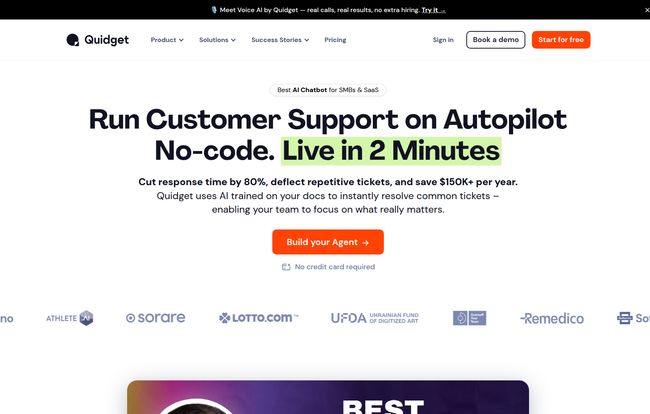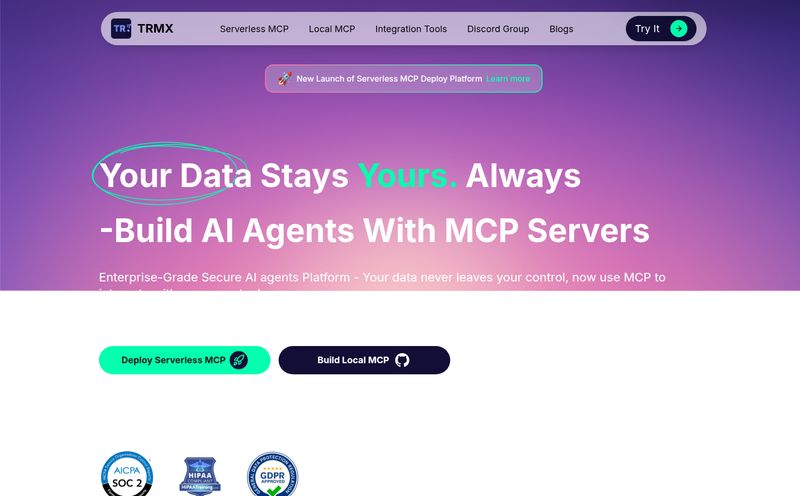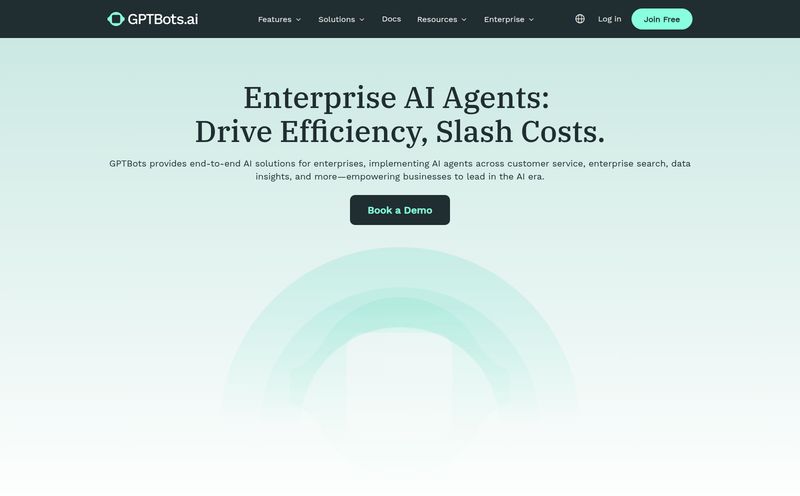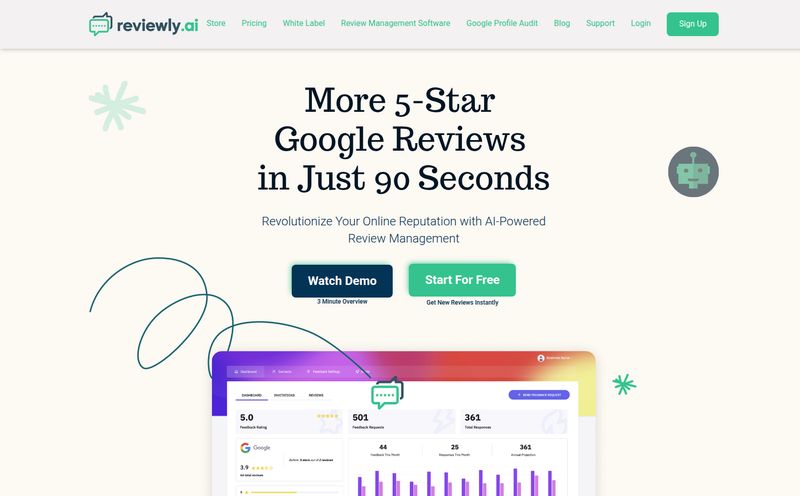If you've run any kind of online business, you know the sound. The relentless ping of the customer support chat. It's the same handful of questions, over and over. "Where's my order?" "What are your hours?" "Do you ship to Antarctica?" (Okay, maybe not that last one, but you get it). Each one pulls you or your team away from the work that actually grows the business.
For years, the promise of AI chatbots has been dangling in front of us like a carrot on a stick. The dream of automating that first line of defense. But honestly? Most of them have been a pain to set up, requiring a developer, a fat budget, and the patience of a saint. So when a tool like Quidget comes along, screaming from the rooftops about being a no-code, 5-minute setup, my inner SEO-and-traffic-nerd sits up and pays attention. But I’m also a little skeptical. Is it really that simple? Let's take a look.
So, What is Quidget, Exactly?
At its core, Quidget is an AI chat builder. But here's the part that matters: it’s trained on your data. Think of it less like a generic, off-the-shelf bot and more like hiring a super-eager intern who can read your entire website, your help docs, and your FAQ page in about three seconds and instantly memorize it all. You just point it to your knowledge base, and it starts learning. The goal is to let this AI handle that flood of repetitive, Tier-1 support questions, freeing up your human agents for the stuff that actually requires a brain and some empathy.
It promises to speak over 45 languages right out of the box, which is a massive plus for anyone with an international audience. No more clunky Google Translate moments in the support chat. And it’s built to work with the tools you're probably already using.

Visit Quidget
The Features That Actually Move the Needle
A lot of platforms throw a kitchen sink of features at you. Most you'll never use. I've found it's better to focus on the handful of things that solve a real problem. For Quidget, it seems to come down to these.
Training on Your Own Turf
This is the big one. The quality of an AI chatbot lives and dies by its training data. The fact that Quidget learns from your own content is crucial. It means the answers it gives are based on your policies, your product info, and your voice. It’s the difference between a bot that says “I can’t find that information” and one that says “Yes, our return policy is 30 days, and you can start the process here.”
Playing Nice with Your Existing Tools
Nothing is worse than a new tool that refuses to integrate with your current workflow. It’s like bringing a new person to a party who won’t talk to any of your friends. Quidget seems to get this. It integrates directly with a solid list of platforms: Zendesk, Freshdesk, Slack, WhatsApp, Telegram, Viber, and even Calendly. This means you can slot it into your process without having to rip everything apart. That Zendesk integration alone is a lifesaver for so many support teams.
The All-Important Human Handoff
I'm a firm believer that AI should augment humans, not replace them entirely. The moment a customer gets stuck in an endless loop with a stupid bot is the moment you risk losing them forever. Quidget has a built-in human handoff feature. When the bot gets a question it can’t handle or the customer types “talk to a human,” it can seamlessly transfer the conversation to a live agent. This is non-negotiable for any serious support tool.
Let's Address the Elephant in the Room... That 0% Stat
Okay. This is where my blogger-sense started tingling. On their homepage, Quidget makes some big, bold claims: "Cut response time by 80%, deflect repetitive tickets, and save $150K+ per year." Awesome. I love it. That's the stuff that gets budgets approved.
But then... right below it, in tiny text, it says "Based on customer-reported results from real businesses like yours" and shows three bubbles: 0% auto-rate for customer questions, 0% reduction in support tickets, and 0% reduction in response time. Uh... what?
I've been in this industry for a while, and my gut tells me this is a classic case of a placeholder that someone forgot to update before pushing the site live. It’s a bit of a gaffe, and it totally undercuts their main headline. I have to believe their actual results are better than zero, otherwise, they wouldn't have any customers or those shiny 4.7-star ratings. It’s a quirky contradiction, and while it gives me a chuckle, it’s something I’d ask about on a demo call. For now, I'm going to file this under "growing pains" and assume the real numbers are much better. But it’s a good reminder to always look at the fine print!
A Look at Quidget's Pricing Tiers
Pricing is always the million-dollar question, or in this case, the $16-dollar question. Quidget breaks down its plans pretty logically, targeting different business sizes. It's nice to see a clear path for scaling up. They offer a 20% discount for annual billing, which is pretty standard stuff.
| Plan | Monthly Price | Best For | Key Features |
|---|---|---|---|
| Starter | $16 | Small businesses starting with automation. | 500 responses/mo, 1 chatbot, 2 seats. |
| Pro | $79 | Growing businesses needing more capacity. | 5,000 responses/mo, 2 chatbots, 4 seats, live chat. |
| Pro Plus | $210 | High-volume teams that need more power. | 10,000 responses/mo, 5 chatbots, 6 seats, API access. |
| Enterprise | from $599 | Large organizations needing customization. | 50,000+ responses, 10+ chatbots, dedicated manager. |
The Starter plan seems like a no-brainer for a small shop or a solopreneur just looking to dip their toes in the water. The Pro plan is where it gets interesting for established teams, adding live chat and more capacity. Once you hit the Pro Plus and Enterprise levels, you're talking about serious, scalable support infrastructure.
The Good, The Bad, and The... Quirky?
No tool is perfect. So here's my breakdown of where Quidget shines and where you might want to be cautious.
On the plus side, the ease of use is its biggest selling point. The testimonial from Softr.io says, "Setting up Quidget was surprisingly quick," and that aligns with all of Quidget's marketing. For a team without a developer, this is huge. The multi-language support and deep integrations are also major wins that put it on par with more established players. The potential for cost reduction is undeniable—if you can automate even 30% of your inbound queries, that's a significant saving in person-hours.
On the other hand, remember the "garbage in, garbage out" rule of AI. The bot is only as good as the data you feed it. If your FAQ page is a mess or your website is outdated, the bot is going to be a messy, outdated bot. It also isn't designed for incredibly complex, multi-layered support issues. It’s a specialist for Tier-1, not a jack-of-all-trades. And yeah, there's that quirky 0% stat on their homepage that makes you raise an eyebrow. It’s likely a mistake, but it's not the most confidence-inspiring detail.
My Final Take: Is Quidget a Go or a No?
So, what's the verdict? In my experience, tools like Quidget fill a very specific, and very important, gap in the market. It’s for the business that knows it needs to automate but is terrified of the complexity and cost that usually comes with it. The no-code promise is everything here.
If you're a small to medium-sized business and your support team is constantly getting bogged down by the same 10-20 questions, I think Quidget is absolutely worth a serious look. The entry-level price is low enough to be an easy experiment. It could be the simple, effective first line of defense that you actually get up and running, instead of just talking about it for another year.
My advice? Take the big marketing claims with a healthy dose of salt (as you always should), but be genuinely intrigued by the simplicity it offers. It seems they have a "Start for free" option or a demo booking system. That's your best bet. Try it, test it with your own data, and see if it works for you. It just might be the quiet, efficient little helper your business has been waiting for.
Frequently Asked Questions
- How does Quidget learn my business information?
- Quidget connects to your existing data sources. You can point it to your website URL, sitemap, or knowledge base (like a help center or FAQ page), and it will scan and learn from that content to provide answers.
- Is Quidget really no-code and easy to set up?
- Yes, that's its primary selling point. The entire setup process is designed to be done without any coding knowledge. The platform guides you through connecting your data and deploying the chatbot on your site, claiming it can be done in about 5-10 minutes.
- What happens if the AI bot can't answer a question?
- Quidget has a "human handoff" feature. If a customer's query is too complex for the bot or if they specifically ask to speak with a person, the conversation can be automatically and smoothly transferred to one of your live support agents.
- Does Quidget work with messaging apps like WhatsApp?
- Yes, it integrates with several popular messaging apps, including WhatsApp, Slack, Telegram, and Viber. This allows you to deploy your automated support on the platforms where your customers already are.
- Can I try Quidget before paying for a plan?
- The pricing page on their website has a "Start for free" button for each plan, suggesting there is a free trial or a freemium model available. You can likely test its basic functionality without a credit card.
- How does Quidget compare to more expensive chatbots?
- Quidget seems to compete by focusing on simplicity and ease of use for a lower price point. While larger, more expensive platforms might offer more complex workflow creation or deeper analytics, Quidget's strength is its rapid, no-code deployment for businesses that need to solve the Tier-1 support problem quickly.
Reference and Sources
- Quidget Official Website: https://quidget.ai/
- Quidget Pricing Page: https://quidget.ai/pricing/



